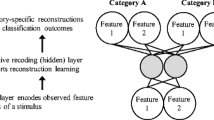Abstract
The introduction of the notion of family resemblance represented a major shift in Wittgenstein’s thoughts on the meaning of words, moving away from a belief that words were well defined, to a view that words denoted less well defined categories of meaning. This paper presents the use of the notion of family resemblance in the area of machine learning as an example of the benefits that can accrue from adopting the kind of paradigm shift taken by Wittgenstein. The paper presents a model capable of learning exemplars using the principle of family resemblance and adopting Bayesian networks for a representation of exemplars. An empirical evaluation is presented on three data sets and shows promising results that suggest that previous assumptions about the way we categories need reopening.
Similar content being viewed by others
References
Addis, T., Billinge, D., & Visscher, B. (2004a). Socially sensitive computing: A necessary paradigm shift for computer science. In Proc. Grand Challenges in Computing (pp. 1–6). Newcastle: UK CPHC.
Addis, J. T., Billinge, D., Gooding, D., & Visscher, B.-F. (2008). The abductive loop: Tracking irrational sets. Foundations of Sciecne. doi:10.1007s/10699-007-9115-6.
Ahn W., Medin L. (1992). A two-stage model of category construction. Cognitive Science 16:81–121
Anderson J.R. (1990). The adaptive character of thought. Hillside, Erlbaum
Bareiss R. (1989). Exemplar-based knowledge acquisition. A unified approach to concept representation, classification, and learning. San Diego, Academic Press Inc
Blake, C., & Merz, C. (1998). UCI repository of machine learning databases. Irvine: University of California, USA, (http://www.ics.uci.edu/mlearn/MLRepository.html)
Pearl J. (1991). Probabilistic reasoning in intelligent systems: Networks of plausible inference. Palo Alto, Morgan Kaufmann
Rodríguez, A., & Vadera, S. (1999). PEBM: A probabilistic exemplar based model. Proceeding of the International Joint Conference on AI (pp. 242–247). San Francisco, USA: Morgan Kaufmann Publishers Inc.
Rosch E., Mervis C.B. (1975). Family resemblance studies in the internal structure of categories. Cognitive Psychology 7:573–605
Wittgenstein, L. (1921). Tractus Logico-Philosophicus. (English edition, 1961). London: Routledge and Kegan Paul.
Wittgenstein L. (1953). Philosophical investigations. Oxford, Blackwell
Author information
Authors and Affiliations
Corresponding author
Rights and permissions
About this article
Cite this article
Vadera, S., Rodriguez, A., Succar, E. et al. Using Wittgenstein’s Family Resemblance Principle to Learn Exemplars. Found Sci 13, 67–74 (2008). https://doi.org/10.1007/s10699-007-9119-2
Published:
Issue Date:
DOI: https://doi.org/10.1007/s10699-007-9119-2




